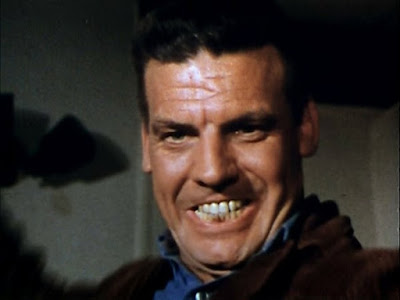Blood of Ghastly Horror manages to pull off the insanely difficult feat of being uniquely strange and boring at the same time. I can't really recommend this film, but it's one of a kind, even though it's technically two of a kind. I'll explain. The bulk of this film uses footage from two previous Al Adamson movies, the first released in the mid-1960s as Psycho a Go-Go. That movie was a crime thriller about a jewel heist gone bad. When it didn't make much money, Adamson decided to retool it as a horror film, shooting some additional scenes about mad scientists and brain transplants and releasing it in the late 1960s as The Fiend with the Electronic Brain. In 1972, he decided to combine elements from both of those films and add some voodoo zombies and homicide detectives to the mix because why the hell not, and Blood of Ghastly Horror was born.
Needless to say, the transitions aren't seamless. The characters in the '70s horror portion of the movie frequently explain how this part of the action is connected to the previously released footage, the image gets wavy while they talk, and then we get a lengthy flashback sequence from Psycho a Go-Go and/or The Fiend with the Electronic Brain. In the case of the latter retooling, we even get flashbacks within flashbacks.The three parts of the film blend awkwardly, and it's a little too obvious that this nutty-ass movie is actually three nutty-ass movies Frankensteined together.
So, what the hell is this thing even about? I'll make an attempt at a broad synopsis. Joe Corey is a Vietnam vet who has been severely psychologically damaged by the war. His doctor, Howard Vanard, has been experimenting with electronic brain simulators that can replace damaged parts of the brain and allow the patient to function normally again. He experiments on Corey without his consent, and the brain transplantation goes wrong. The doc accidentally erases Corey's empathy and judgment, and Corey becomes a murderer, a thief, a member of a crime syndicate, and a creep to women. He's part of a big jewel heist and some messed-up stuff that results from the robbery. Meanwhile, Corey's dad, a scientist who spent time studying voodoo, vows revenge on everyone who hurt his son. He does this by kidnapping people and turning them into his zombie slaves.
I salute and honor insane ideas like this, but the results are mostly less than intriguing. Adamson occasionally stumbles into a cool shot or a suspenseful scene, but the majority of the film is stiff and labored, and a chase in the mountains goes on for an interminable length of time. His framing of shots is extremely weird, and actors are, seemingly at random, sometimes shown in extreme closeup with only a quarter of their face in the frame and sometimes presented more conventionally. This is also a film where violence against men is dealt with quickly, but the camera lingers when women are the victims, with only a few exceptions.
The cast of mostly unknowns features two well-known actors on the downward slide of fame. John Carradine plays Dr. Vanard, and former Disney star Tommy Kirk is one of the homicide detectives. Behind the camera, though, was a major talent paying his dues early in his career. Legendary cinematographer Vilmos Zsigmond shot the Psycho a Go-Go portion of the film, and he went on to a pretty amazing career that lasted until a few years before his death in 2016. After a decade of work in low-budget obscurities, Zsigmond was the cinematographer for McCabe & Mrs. Miller, The Hired Hand, Images, Deliverance, The Long Goodbye, Scarecrow, Cinderella Liberty, The Sugarland Express, Obsession, Close Encounters of the Third Kind, some of The Last Waltz, The Deer Hunter, Heaven's Gate, Blow Out, Real Genius, The Witches of Eastwick, The Crossing Guard, and two seasons of The Mindy Project.
Saturday, April 7, 2018
Subscribe to:
Post Comments (Atom)






No comments:
Post a Comment